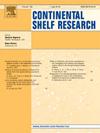巴西abrolhos银行卫星温度和热应力的时空可靠性
IF 2.2
3区 地球科学
Q2 OCEANOGRAPHY
引用次数: 0
摘要
需要对海洋温度进行准确估计,以评估其后果并改进对珊瑚礁热应力的预测。由于海洋热浪造成的大规模珊瑚白化和死亡事件,珊瑚礁在全球范围内正在减少。在这里,我们将从NOAA珊瑚礁观察(CoralTemp)中恢复的卫星获得的海面温度(SSTs)与2012年至2018年在西南大西洋最大的珊瑚礁(巴西Abrolhos Bank)内九个地点不同深度测量的原位温度进行了对比。我们的结果显示,在10米深度或混合层内进行的测量中,两个数据集之间存在很强的相关性(超过0.95)。在干旱期(4 ~ 9月),当水柱均匀且海气界面净热通量为负时,混合层以下或底部的温度数据与CoralTemp一致。然而,在雨季(10月至3月),由于水柱下半部分出现冷水,现场测量值要低得多(在某些地点高达4°C)。在第三次全球白化事件(2016-2017)期间,浅层珊瑚礁的白化程度比CoralTemp估计的热应力更严重。尽管如此,它们在整个夏秋季节保持较低原位温度的较深珊瑚礁中的位置较低。虽然我们确认CoralTemp数据提供了可靠的海表温度(SSTs)来源,但在推断更深深度的热应力时,特别是在深度超过20米的中深水点,建议谨慎。本文章由计算机程序翻译,如有差异,请以英文原文为准。
Spatial-temporal reliability of satellite-derived temperature and thermal stress in the abrolhos bank, Brazil
Accurate estimates of ocean temperatures are needed to assess the consequences and improve predictions of thermal stress over coral reefs, which are declining globally due to mass coral bleaching and mortality episodes caused by maritime heatwaves. Here, we contrasted satellite-derived sea surface temperatures (SSTs) recovered from NOAA Coral Reef Watch (CoralTemp) with in situ temperatures measured between 2012 and 2018 in nine locations within the Southwestern Atlantic's largest coral reefs (Abrolhos Bank, Brazil), at different depths. Our results revealed a strong correlation (over 0.95) between the two datasets for measurements carried out to 10 m depths or within the mixed layer. In the dry period (April to September), when the water column is homogenous and the net heat flux through the air-sea interface is negative, temperature data collected below the mixing layer or at the bottom were consistent with CoralTemp. However, in situ measurements were much lower (up to 4 °C at some sites) during the rainy period (from October to March) due to cold water occurrence in the bottom half of the water column. During the Third Global Bleaching Event (2016–2017) bleaching levels in shallow reefs were more intense than the thermal stress estimated by CoralTemp. Still, they were lower in the deeper reefs that remained with lower in situ temperatures throughout the summer and autumn. While we confirm that CoralTemp data provide a reliable source of sea surface temperatures (SSTs), caution is advised when inferring thermal stress at greater depths, particularly in mesophotic sites deeper than 20 m.
求助全文
通过发布文献求助,成功后即可免费获取论文全文。
去求助
来源期刊

Continental Shelf Research
地学-海洋学
CiteScore
4.30
自引率
4.30%
发文量
136
审稿时长
6.1 months
期刊介绍:
Continental Shelf Research publishes articles dealing with the biological, chemical, geological and physical oceanography of the shallow marine environment, from coastal and estuarine waters out to the shelf break. The continental shelf is a critical environment within the land-ocean continuum, and many processes, functions and problems in the continental shelf are driven by terrestrial inputs transported through the rivers and estuaries to the coastal and continental shelf areas. Manuscripts that deal with these topics must make a clear link to the continental shelf. Examples of research areas include:
Physical sedimentology and geomorphology
Geochemistry of the coastal ocean (inorganic and organic)
Marine environment and anthropogenic effects
Interaction of physical dynamics with natural and manmade shoreline features
Benthic, phytoplankton and zooplankton ecology
Coastal water and sediment quality, and ecosystem health
Benthic-pelagic coupling (physical and biogeochemical)
Interactions between physical dynamics (waves, currents, mixing, etc.) and biogeochemical cycles
Estuarine, coastal and shelf sea modelling and process studies.
 求助内容:
求助内容: 应助结果提醒方式:
应助结果提醒方式:


